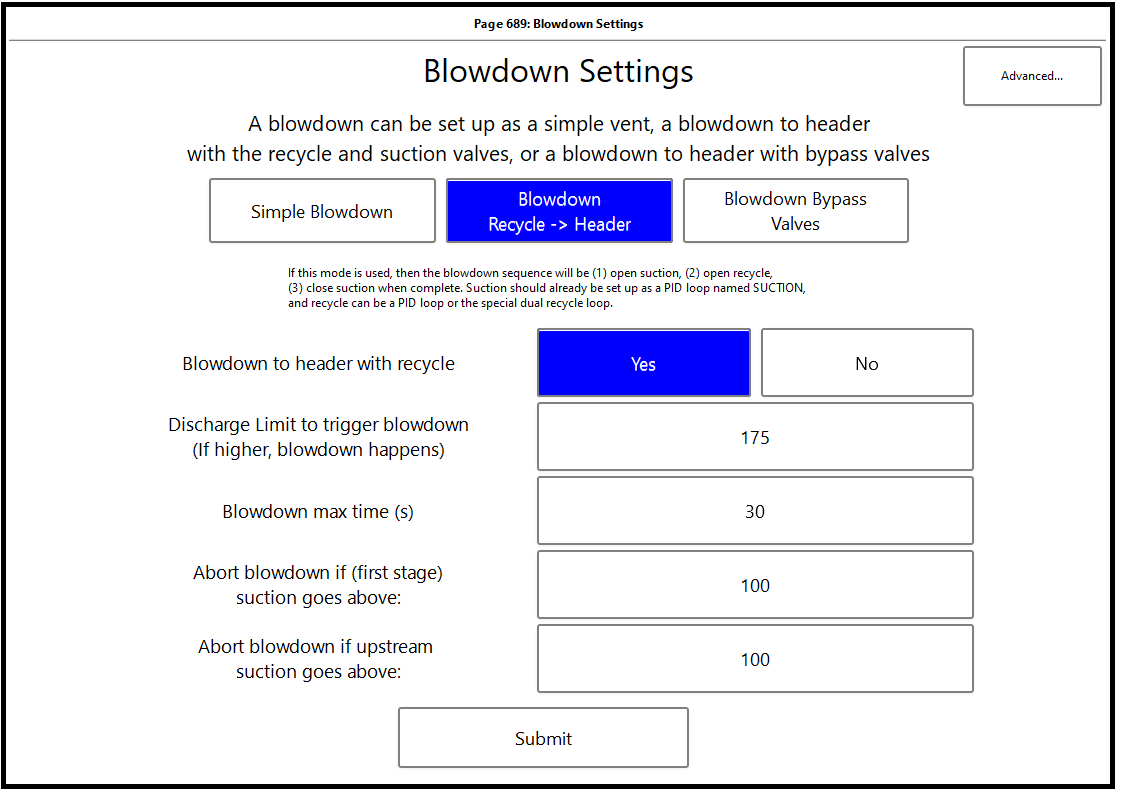Blowdown With Recycle Sequence
From EMIT Controls
Overview
The Dynamic Control panels have three options related to relieving pressure on a unit:
- Blowdown vent, with a simple vent, usually to atmosphere or combuster
- Blowdown to header with recycle, where suction and recycle valves are used to relieve to header
- Off skid bypass, where an off-skid on/off valve is used to relieve pressure to the header
This article covers option (2).
Setting Up Valves
Before enabling this option, the valve(s) must be configured.
- The recycle valve can be set up as a normal PID loop named “RECYCLE” that runs off of one input (suction or discharge), or it can use the built-in recycle loop that runs off both suction and discharge. The second option is preferred since it is cleaner. See Dual_Recycle_Setup
- The suction valve is set up as a normal PID loop named “SUCTION”
Sequence Setup
The blowdown to header with recycle can be enabled at Settings – Brain – “Outputs Setup” – “Blowdown Settings”. The second tab covers the options for this function, and a screenshot is shown below.
Settings on this page:
- “Blowdown to header with recycle”: Set to Yes to use
- Discharge limit: This option gives a value, in PSI, that will trigger this sequence during startup. If the unit START begins and the final discharge is above this value, the sequence will happen. If the discharge is already below this value, the sequence will not happen.
- Blowdown max time: This gives the maximum time the sequence will try to complete. For example, if the recycle is not working and doesn’t open then the operation will time out because the pressures are not changing.
- Pressure aborts: The sequence can abort if the first stage suction or upstream suction sensor(s) go above the defined values. This protects first stage equipment from going over-pressure.
Sequence of Operations
- Unit is stopped
- Recycle is closed
- If load control mode is used, suction is closed
- If load control mode is not used, suction position depends on PID loop activation criteria for suction PID
- The user presses RESET then START to start the unit.
- If the final discharge pressure is above the value set on the page above “Discharge limit to trigger blowdown”, the sequence begins. If not, the sequence skips to purge (if used) or pre-lube.
- The siren sounds for 4 seconds in a double-beep pattern.
- The suction is slowly opened until half open
- The rate that the suction valve opens is determined by purge sequence setup value “Suction open rate pct/sec”, even if purge is not used. Default is 5 pct /sec, aka 10 seconds to get to half open.
- The recycle valve is slowly opened.
- Once the final discharge is below the limit in (3), move to the next stage.
- The next stage is pre-lube.
- Recycle will be forced to stay open until the unit is done idling, at which time the normal loop resumes based on the suction and/or discharge pressures.
- If load control mode is used, the suction valve will go to 25 pct open until unit starts.
- If load control mode is not used, the suction valve returns to normal PID logic, with the position depending on how the activation criteria is set up for the PID loop.
- If the first stage suction or upstream suction pressure goes above the abort limit at any point, sequence faults out and recycle is closed.
- If the maximum time limit is reached and the final discharge is still not below the limit in (3), sequence faults out and recycle is closed.
